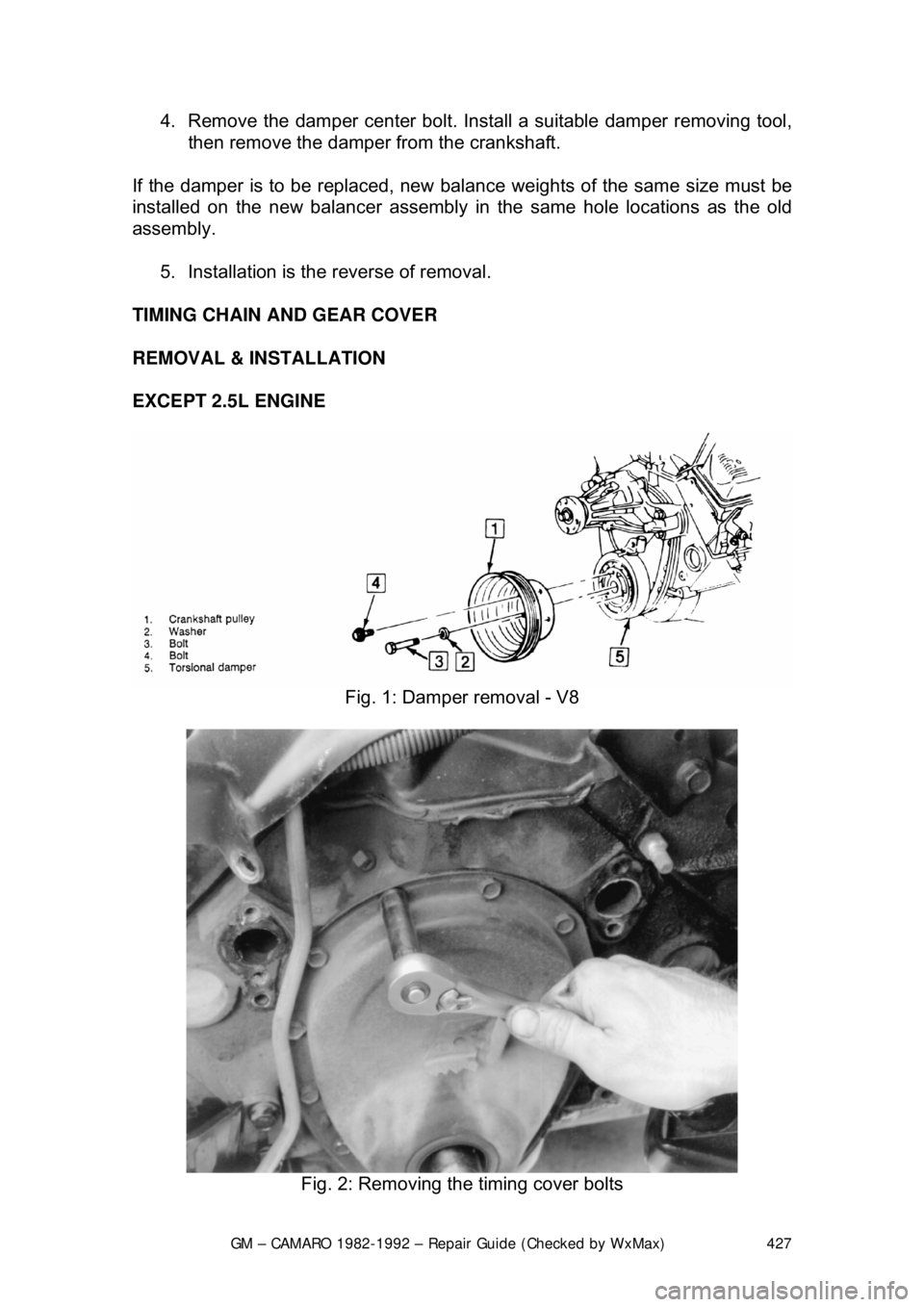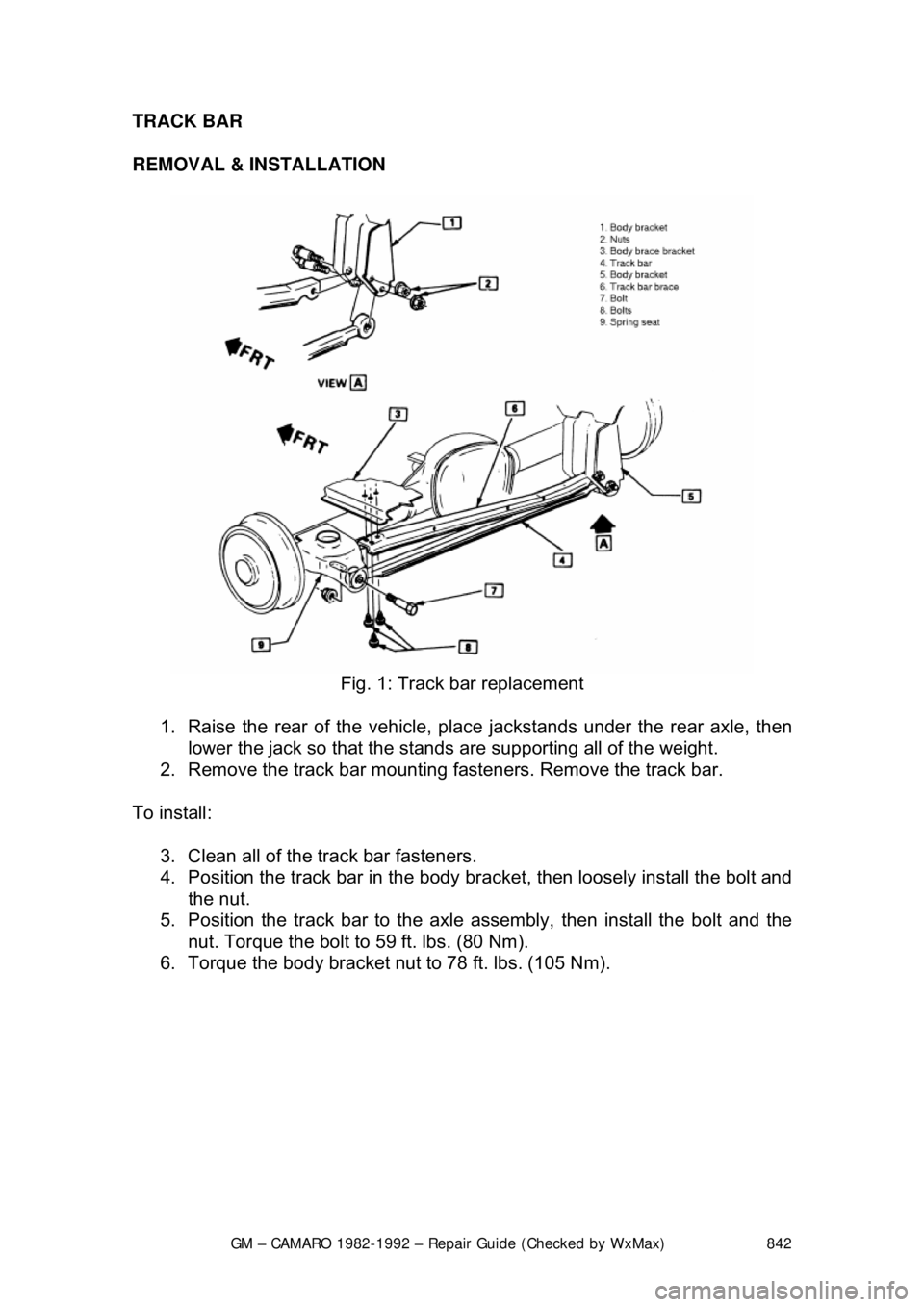1982 CHEVROLET CAMARO weight
[x] Cancel search: weightPage 294 of 875

GM – CAMARO 1982-1992 – Repair Guide (Checked by WxMax) 294
25. Connect the negative battery cable at the battery.
CLUTCH
UNDERSTANDING THE CLUTCH
The purpose of the clutch is to disconnect and connect engine power at the
transmission. A vehicle at rest requires a lot of engine torque to get all that
weight moving. An internal combustion engine does not develop a high starting
torque (unlike steam engines) so it must be allowed to operate without any load
until it builds up enough torque to move the vehicle. To a point, torque
increases with engine rpm. The clutch a llows the engine to build up torque by
physically disconnecting t he engine from the transmission, relieving the engine
of any load or resistance.
The transfer of engine power to the tr ansmission (the load) must be smooth and
gradual; if it weren't, driv e line components would wear out or break quickly.
This gradual power transfer is made possi ble by gradually releasing the clutch
pedal. The clutch disc and pressure plat e are the connecting link between the
engine and transmission. When the clutch pedal is released, the disc and plate
contact each other (the clutch is engag ed) physically joining the engine and
transmission. When the pedal is pushed in, the disc and plate separate (the
clutch is disengaged) disconnecting the engine from the transmission.
Most clutch assemblies consists of t he flywheel, the clutch disc, the clutch
pressure plate, the throw out bearing and fork, the actuating linkage and the
pedal. The flywheel and clutch pressure plate (driving members) are connected
to the engine crankshaft and rotate with it. The clutch disc is located between
the flywheel and pressure plate, and is splined to the transmission shaft. A
driving member is one that is attached to the engine and transfers engine power
to a driven member (clutch disc) on t he transmission shaft. A driving member
(pressure plate) rotates (drives) a driv en member (clutch disc) on contact and,
in so doing, turns the transmission shaft.
There is a circular di aphragm spring within th e pressure plate cover
(transmission side). In a relaxed state (w hen the clutch pedal is fully released)
this spring is convex; that is, it is dished outward toward the transmission.
Pushing in the clutch peda l actuates the attached linkage. Connected to the
other end of this is the throw out fork, which hold the throw out bearing. When
the clutch pedal is depre ssed, the clutch linkage pushes the fork and bearing
forward to contact the diaphragm spring of the pressure plate. The outer edges
of the spring are secured to the pressure plate and are pivoted on rings so that
when the center of the spring is compre ssed by the throw out bearing, the outer
edges bow outward and, by so doing, pu ll the pressure plate in the same
direction - away from the clutch disc. This action se parates the disc from the
plate, disengaging the clutch and allowing the transmission to be shifted into
another gear. A coil type clutch return sp ring attached to the clutch pedal arm
permits full release of the pedal. Releasing the pedal pulls the throw out bearing
away from the diaphragm spring resulting in a reversal of spring position. As
bearing pressure is gradually released from the spring center, the outer edges
Page 427 of 875

GM – CAMARO 1982-1992 – Repair Guide (Checked by WxMax) 427
4. Remove the damper center bolt. Inst
all a suitable damper removing tool,
then remove the damper fr om the crankshaft.
If the damper is to be replaced, new balanc e weights of the same size must be
installed on the new balancer assembly in the same hole locations as the old
assembly.
5. Installation is the reverse of removal.
TIMING CHAIN AND GEAR COVER
REMOVAL & INSTALLATION
EXCEPT 2.5L ENGINE
Fig. 1: Damper removal - V8
Fig. 2: Removing the timing cover bolts
Page 469 of 875

GM – CAMARO 1982-1992 – Repair Guide (Checked by WxMax) 469
ENGINE OVERHAUL TIPS
Most engine overhaul procedures are fair
ly standard. In addition to specific
parts replacement procedures and specifications for your individual engine, this
section is also a guide to acceptabl e rebuilding procedures. Examples of
standard rebuilding practice are given and should be used along with specific
details concerning your particular engine.
Competent and accurate machine sh op services will ensure maximum
performance, reliability and engin e life. In most instances it is more profitable for
the do-it-yourself mechanic to remove, clean and inspect the component, buy
the necessary parts and deliver these to a shop for actual machine work.
Much of the assembly work (crankshaft, bearings, piston rods, and other
components) is well within the scope of t he do-it-yourself mechanic's tools and
abilities. You will have to decide for your self the depth of involvement you desire
in an engine repair or rebuild.
TOOLS
The tools required for an engine overhaul or parts replacement will depend on
the depth of your involvement. With a few exceptions, they will be the tools
found in a mechanic's tool kit (see Gener al Information & Maintenance in this
repair guide). More in-depth work will requ ire some or all of the following:
• A dial indicator (reading in thousandths) mounted on a universal base
• Micrometers and telescope gauges
• Jaw and screw-type pullers
• Scraper
• Valve spring compressor
• Ring groove cleaner
• Piston ring expander and compressor
• Ridge reamer
• Cylinder hone or glaze breaker
• Plastigage®
• Engine stand
The use of most of these tools is illustra ted in this section. Many can be rented
for a one-time use from a local parts jobber or tool supply house specializing in
automotive work.
Occasionally, the use of special tools is called for. See the information on
Special Tools and the Safety Notice in General Information & Maintenance
before substituting another tool.
OVERHAUL TIPS
Aluminum has become extr emely popular for use in engines, due to its low
weight. Observe the follo wing precautions when handl ing aluminum parts:
Page 477 of 875

GM – CAMARO 1982-1992 – Repair Guide (Checked by WxMax) 477
Most cylinder heads these days are made of
an aluminum alloy due to its light
weight, durability and heat transfer qualit ies. However, cast iron was the
material of choice in the past, and is st ill used on many vehicles today. Whether
made from aluminum or iron, all cylinder heads hav e valves and seats. Some
use two valves per cylinder, while the more hi-tech engines will utilize a multi-
valve configuration using 3, 4 and
even 5 valves per cylinder. When the va lve contacts the seat, it does so on
precision machined surfaces, which seal s the combustion chamber. All cylinder
heads have a valve guide for each valve. The guide centers the valve to the
seat and allows it to move up and down within it. The clearance between the
valve and guide can be critical. Too much clearance and the engine may
consume oil, lose vacuum and/or damage the seat. Too little, and the valve can
stick in the guide causing t he engine to run poorly if at all, and possibly causing
severe damage. The last component all cylinder heads have are valve springs.
The spring holds the valve against its s eat. It also returns the valve to this
position when the valve has been opened by the valve train or camshaft. The
spring is fastened to the valve by a retainer and valve locks (sometime\
s called
keepers). Aluminum heads will also have a valve spring shim to keep the spring
from wearing away the aluminum.
An ideal method of rebuilding the cylin der head would involve replacing all of
the valves, guides, seats, springs, et c. with new ones. However, depending on
how the engine was maintained, often this is not necessary. A major cause of
valve, guide and seat wear is an improperly tuned engine. An engine that is
running too rich, will often wash the lubric ating oil out of the guide with gasoline,
causing it to wear rapidly. Conversely, an engine which is running too lean will
place higher combustion temperatures on the valves and seats allowing them to
wear or even burn. Springs fall victim to the driving habits of the individual. A
driver who often runs the engine rpm to the redline will wear out or break the
springs faster then one that stays well below it. Unfortunately, mileage takes it
toll on all of the parts. G enerally, the valves, guides, springs and seats in a
cylinder head can be machined and re-used, saving you money. However, if a
valve is burnt, it may be wise to replace all of the valves, since they were all
operating in the same environment. The same goes for any other component\
on
the cylinder head. Think of it as an insurance policy against future problems
related to that component.
Unfortunately, the only way to find out wh ich components need replacing, is to
disassemble and carefully check each piece. After the cylinder head(s) are
disassembled, thoroughly clean all of the components.
DISASSEMBLY
Before disassembling the cylinder head, you may want to fabricate some
containers to hold the various parts, as some of them can be quite small (such
as keepers) and easily lost. Also keeping yourself and the components
organized will aid in assembly and reduce confusion. Where possible, try to
maintain a components original location; th is is especially important if there is
not going to be any machine work performed on the components.
Page 842 of 875

GM – CAMARO 1982-1992 – Repair Guide (Checked by WxMax) 842
TRACK BAR
REMOVAL & INSTALLATION
Fig. 1: Track bar replacement
1. Raise the rear of the vehicle, pl ace jackstands under the rear axle, then
lower the jack so that the stands are supporting all of the weight.
2. Remove the track bar mounting fasteners. Remove the track bar.
To install: 3. Clean all of the track bar fasteners.
4. Position the track bar in the body br acket, then loosely install the bolt and
the nut.
5. Position the track bar to the axle assembly, then install the bolt and the
nut. Torque the bolt to 59 ft. lbs. (80 Nm).
6. Torque the body bracket nut to 78 ft. lbs. (105 Nm).
Page 843 of 875

GM – CAMARO 1982-1992 – Repair Guide (Checked by WxMax) 843
TRACK BAR BRACE
REMOVAL & INSTALLATION
1. Raise the rear of the vehicle, pl ace jackstands under the rear axle, then
lower the jack so that the stands are supporting all of the weight.
2. Remove the heat shield screw s from the track bar brace.
3. Remove the three track bar brace-to-body brace screws.
4. Remove the track bar-to-body bra cket fasteners and remove the track
bar brace.
To install: 5. Place the track bar brace into position.
6. Install the track bar-to-body bracket fasteners.
7. Install the three track bar brace-to-body brace screws.
8. Install the heat shield scre ws to the track bar brace.
9. Lower the vehicle.
CONTROL ARM
REMOVAL & INSTALLATION
Remove/reinstall only one lower control ar m at a time. If both arms are removed
at the same time, the axle could roll or slip sideways, making reinstallation of
the arms very difficult.
1. Raise the rear of the vehicle, pl ace jackstands under the rear axle, then
lower the jack so that the stands are supporting all of the weight.
2. Remove the control arm attachi ng fasteners, then remove the control
arm.
3. Installation is a simple matter of bol ting the arm into place. Torque the 3
bolts at the body brace bracket to 35 ft. lbs. (47 Nm) and the nut at the
body bracket to 61 ft. lbs. (83 Nm).
TORQUE ARM
REMOVAL & INSTALLATION
The coil springs must be removed BEFORE the torque arm. If the torque arm is
removed first, vehicle damage will result. In order to proceed, the vehicle must
be supported in a manner whic h will allow the rear axle height to be adjusted
independently of the body height.
1. Remove the track bar mounting bolt at the axle assembly, then loosen
the track bar bolt at the body brace.
2. Disconnect the rear brake hose clip at the axle assembly, which will allow
additional drop of the axle.
3. Remove the lower attaching nuts from both rear shock absorbers.
4. Disconnect the shock absorbers from their lower attaching points.
Page 844 of 875

GM – CAMARO 1982-1992 – Repair Guide (Checked by WxMax) 844
5. On models with four cylinder engines, remove the driveshaft.
6. Carefully lower the rear axle asse
mbly and remove the rear coil springs.
CAUTION - DO NOT overstretch the br ake hose when lowering the axle-
damage to the hose will result.
7. Remove the torque arm rear attaching bolts.
8. Remove the front torq ue arm outer bracket.
9. Remove the torque ar m from the vehicle.
To install: 10. Place the torque arm in position and loosely install the rear torque arm
bolts.
11. Install the front torque arm bracket and torque the nuts to 31 ft. lbs. (42
Nm).
12. Torque the rear torque arm nuts to 100 ft. lbs. (135 Nm).
13. Place the rear springs and insulators in position, then raise the rear axle
assembly until all of the weight is supported by the spring.
14. Attach the shock absorbers to the rear axle and torque the fasteners to
70 ft. lbs. (95 Nm).
15. Clean and reinstall the track bar mounting bolt at the axle. Torque the
bolt to 59 ft. lbs. (80 Nm).
16. Clean and reinstall the track bar-t o-body brace nut. Torque the nut to 78
ft. lbs. (105 Nm).
17. Install the brake line clip to the underbody.
18. On four cylinder models, reinstall the driveshaft.
19. Lower the vehicle.